Commercial & Industrial Flat Roofing
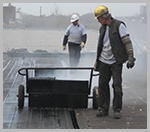 |
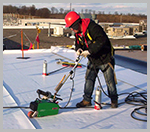 |
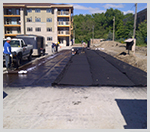 |
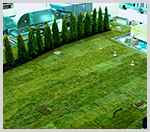 |
Multi-ply |
Single-ply |
Fluid Applied |
Green Roofing |
Multi-ply
BUR (Built Up Roofing/Tar and Gravel)
The BUR system is tried and true. It has been around longer than any of the other systems have. Providing it with a solid track record. The BURs high quality is largely due to its resiliency to erosion. Its ballast topping is effective in fighting off weather elements, such as providing reflection against hot sun rays. The BURs solid structure provides it further durability in a sense of puncture resistance. This makes it a good choice in high traffic areas. Such as buildings which require foot traffic for HVAC maintenance or common areas.
A BUR system is composed of multiple membrane plies surfaced with a layer of aggregate. Each component is adhered together with bitumen asphalt, layer by layer. The membrane plies serve as the reinforcement. The aggregate protects from weather elements. While the asphalt glues the system together it also provides the waterproofing component.
SBS Modified Bitumen (Styrene Butadiene Styrene)
SBS is a close cousin of the BUR. It has been around long enough to stand the test of time. In addition, it is durable in a sense of puncture resistance. It can be installed in high traffic areas. For example, the SBS can be used on decks which are walkable terraces. As seen often on condominiums, apartments and office buildings. It is versatile as it can be installed in numerous ways. Unlike the BUR installation, it does not require the use of asphalt or gravel. Also, heavy equipment is not required, making the installation faster. There are different colours which can be used to achieve a certain look or solar reflectivity.
The SBS system is generally composed of two membrane plies. The top ply is coated with aggregate granules. The system can be installed in three ways. It can be torched down (when economy is a concern), adhered with hot asphalt (when safety is a concern) or by way of peel and stick (when accessibility is a concern). The membrane plies provide reinforcement and elasticity. While the aggregate granules on top protect against weather elements.
Single-ply
TPO & PVC
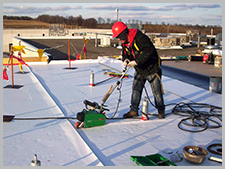 TPO and PVC share many of the same qualities. They are lightweight systems. Making them effective for roof replacement projects, in which the system is installed over top of an existing roof. Without ever having to remove the existing roof. Making the project more economical. Since they are lightweight, heavy machinery is not required for installation. Also, installation is less labour intensive. Making for high-speed application process. They are a good choice for major industrial buildings or retail plazas. These systems are built in-house and factory approved before application. Which means they face a better chance against defects than systems which are built on-site.
TPO and PVC share many of the same qualities. They are lightweight systems. Making them effective for roof replacement projects, in which the system is installed over top of an existing roof. Without ever having to remove the existing roof. Making the project more economical. Since they are lightweight, heavy machinery is not required for installation. Also, installation is less labour intensive. Making for high-speed application process. They are a good choice for major industrial buildings or retail plazas. These systems are built in-house and factory approved before application. Which means they face a better chance against defects than systems which are built on-site.
TPO and PVC systems are built solely of inorganic material so they cannot be broken down by water. As well they are highly resistant to animal fats and solvents. That makes them a good choice to use on restaurant buildings, which exhaust that kind of thing. Due to the simplicity of their structure these systems are easy to maintain and track problems with. They are available in different colours to suit style or solar reflectivity.
TPO (Thermoplastic Polyolefin)
A TPO system consists of three layers compounded into one ply. The layers are a composition of fabric and rubber necessary for reinforcement, flexibility and weldabilty. The materials used are not organic. This is so that it cannot be broken down by water. A TPO system can be mechanically fastened or fully adhered with adhesive.
PVC (Polyvinyl Chloride)
A PVC system consists mainly of one vinyl ply. A PVC system can mechanically fastened, fully adhered with adhesive or loose laid with ballast.
EPDM (Ethylene Propylene Diene Terpolymer)
EPDM is similar in characteristic to TPO and PVC systems. An EPDM system consists mainly of one rubber ply. It can be adhered with adhesive or mechanically fastened. It can also be loose laid and weighted down with ballast.
Fluid Applied
Hot Rubberized Asphalt
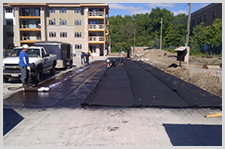 A hot rubberized asphalt system is built on site and applied to the deck in fluid form. It transforms to a solid state after application. Being applied in this way gives it a monolithic structure free of seams. Making it less prone to leaks. Further, its application does not require an open flame. Which is important when safety is a concern. It can be applied to a number of substrates, including concrete decks. This makes it a good choice for high-rise condominiums and office buildings. Which require walkable terraces and green roof elements.
A hot rubberized asphalt system is built on site and applied to the deck in fluid form. It transforms to a solid state after application. Being applied in this way gives it a monolithic structure free of seams. Making it less prone to leaks. Further, its application does not require an open flame. Which is important when safety is a concern. It can be applied to a number of substrates, including concrete decks. This makes it a good choice for high-rise condominiums and office buildings. Which require walkable terraces and green roof elements.
A Hot Rubberized Asphalt system is composed of multiple blends of asphalt and rubber. Two layers of fluid formed asphalt are applied on top of one another. They solidify after application. A layer of fabric is installed between the asphalt layers for reinforcement.
Green Roofing
Green Roofing
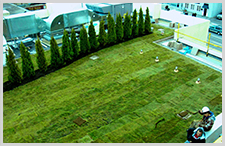 A green roof provides a host of benefits to the building owner and the general environment. A green roof provides a building with superior insulation. Decreasing high cooling costs in the summer. Such makes it a good choice for commercial developments like condominiums, apartments and office buildings. These kind of buildings usually feature recreational areas and with terraces and scenic views. This system also provides a high level of solar reflectivity. This allows the roof to last longer as it cannot be broken down as easily, by heat from the sun.
A green roof provides a host of benefits to the building owner and the general environment. A green roof provides a building with superior insulation. Decreasing high cooling costs in the summer. Such makes it a good choice for commercial developments like condominiums, apartments and office buildings. These kind of buildings usually feature recreational areas and with terraces and scenic views. This system also provides a high level of solar reflectivity. This allows the roof to last longer as it cannot be broken down as easily, by heat from the sun.
Great environmental benefits are had with green roofs in terms of storm water runoff, energy consumption, urban heat island effect, air quality and emissions. Due to these benefits, Toronto has enforced green roofing bylaws on commercial buildings.
Green roofing generally has three components. The greenery fitted in a bed of soil being the main feature. Such is complimented by a root barrier element and a drainage system. The green roof portion of any roof must be installed with a central roof system (HR, SBS or TPO/PVC for ex.). While the purpose of the central roof system is to waterproof the building the green roof’s purposes are explained above. After a building has been fitted with a central roof system the green roof can be installed on top of it.